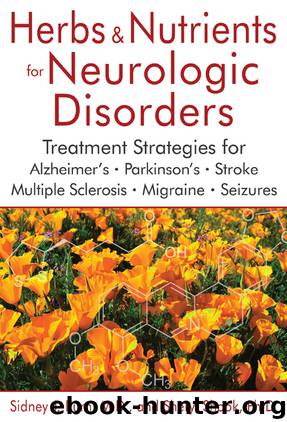Herbs and Nutrients for Neurologic Disorders by Sidney J. Kurn

Author:Sidney J. Kurn
Language: eng
Format: epub
Tags: Health/Herbalism
Publisher: Inner Traditions / Bear & Company
Published: 2016-05-25T16:00:00+00:00
PLATELETS
Drugs that inhibit platelets are commonly used in atherosclerotic disease and its complications, such as myocardial infarction (heart attack) and stroke. The standard drugs include aspirin, Ticlid (ticlopidine), Plavix (clopidogrel), and Persantine (dipyridamole). The first three reduce the incidence of myocardial infarction (MI) and stroke although ticlopidine and clopidogrel are more effective than aspirin. Aspirin inhibits an enzyme, cyclooxygenase, which in turn reduces the formation of thromboxane A2 (TXA2). TXA2 induces platelet aggregation and vasoconstriction. Ticlopidine and clopidogrel inhibit platelet aggregation by reducing the secretion of adenosine diphosphate (ADP), a molecule required for platelet aggregation. Dipyridamole inhibits platelet uptake of a molecule called adenosine. Through a cascade of events, this inhibition results in reduced aggregation of platelets. Newer therapies involve the combination of platelet inhibitors such as aspirin and Aggrenox (dipyridamole).
The role of platelets in atherosclerosis involves multiple information molecules and a complex interaction with endothelial cells, the inner lining of blood vessels. Platelets and endothelial cells manufacture adhesion molecules, responsible for binding of white blood cells to the endothelium (an important step in atherosclerosis). In addition, platelets appear to manufacture amyloid precursor protein (APP), known for its role in Alzheimer’s disease (AD). Macrophages, essential inflammatory molecules, consume platelets and convert APP into beta-amyloid protein, with a resultant inflammatory cascade accelerating atherosclerosis.79 This parallels the process in AD, reinforcing evidence for inflammation’s significant role in numerous disease processes. Platelets activate smooth muscle cell expression of thrombospondin, which appears to provoke smooth muscle cells in vascular walls to proliferate.80 Smooth muscle cell proliferation is an essential step in atherosclerosis. Finally, platelets secrete a factor called platelet factor 4 (PF4), which binds to oxidized LDL and increases oxidized LDL binding to vascular cells and macrophages. It also appears to block the binding and degradation of nonoxidized LDL, thereby leading to increased oxidized LDL levels.81
Ginkgo biloba, the maidenhair tree, is the oldest living tree species, dating back two hundred million years. Extracts of the leaves have a number of properties that suggest their utility in atherosclerosis and stroke. It is a potent inhibitor of a phospholipid, platelet-activating factor (PAF), which promotes platelet aggregation and has a broad range of effects in a variety of tissues.82 PAF appears to act on a specific cell receptor, initiating intracellular signaling processes that ultimately affect gene transcription. It contributes to inflammation, and it induced death of the main structural cell in the central nervous system (CNS) of the glial cell, as shown in a 2002 report.83 PAF is found in atherosclerotic plaques and appears to play an important role in atherosclerosis.84 Ginkgo extracts may inhibit other atherosclerotic molecular processes noted above. This includes inhibiting the toxic effects of beta-amyloid85 and preventing the adhesion of inflammatory cells to endothelial cells that line the lumen of blood vessels.86 Ginkgo biloba appears to reduce the proliferation of vascular smooth muscle cells87 and inhibits the activation of NF-kappaB by hydrogen peroxide,88 both processes essential to atherosclerosis.
Experimental and clinical work on Ginkgo biloba extracts confirms its utility in cerebrovascular disease. Animal studies
Download
This site does not store any files on its server. We only index and link to content provided by other sites. Please contact the content providers to delete copyright contents if any and email us, we'll remove relevant links or contents immediately.
Periodization Training for Sports by Tudor Bompa(8170)
Why We Sleep: Unlocking the Power of Sleep and Dreams by Matthew Walker(6618)
Paper Towns by Green John(5089)
The Immortal Life of Henrietta Lacks by Rebecca Skloot(4525)
The Sports Rules Book by Human Kinetics(4291)
Dynamic Alignment Through Imagery by Eric Franklin(4116)
ACSM's Complete Guide to Fitness & Health by ACSM(3989)
Kaplan MCAT Organic Chemistry Review: Created for MCAT 2015 (Kaplan Test Prep) by Kaplan(3939)
Introduction to Kinesiology by Shirl J. Hoffman(3725)
Livewired by David Eagleman(3683)
The Death of the Heart by Elizabeth Bowen(3551)
The River of Consciousness by Oliver Sacks(3538)
Alchemy and Alchemists by C. J. S. Thompson(3449)
Bad Pharma by Ben Goldacre(3355)
Descartes' Error by Antonio Damasio(3230)
The Emperor of All Maladies: A Biography of Cancer by Siddhartha Mukherjee(3064)
The Gene: An Intimate History by Siddhartha Mukherjee(3047)
The Fate of Rome: Climate, Disease, and the End of an Empire (The Princeton History of the Ancient World) by Kyle Harper(3003)
Kaplan MCAT Behavioral Sciences Review: Created for MCAT 2015 (Kaplan Test Prep) by Kaplan(2936)
